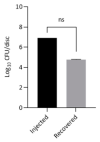Sheep as a Potential Model of Intradiscal Infection by the Bacterium Cutibacterium acnes
- PMID: 33809558
- PMCID: PMC8002071
- DOI: 10.3390/vetsci8030048
Sheep as a Potential Model of Intradiscal Infection by the Bacterium Cutibacterium acnes
Abstract
The anaerobic bacterium Cutibacterium acnes has been increasingly linked to the development of degenerative disc disease (DDD), although causality is yet to be conclusively proven. To better study how this organism could contribute to the aetiology of DDD, improved animal models that are more reflective of human disc anatomy, biology and mechanical properties are required. Against this background, our proof-of concept study aimed to be the first demonstration that C. acnes could be safely administered percutaneously into sheep intervertebral discs (IVDs) for in vivo study. Following our protocol, two sheep were successfully injected with a strain of C. acnes (8.3 × 106 CFU/disc) previously recovered from a human degenerative disc. No adverse reactions were noted, and at one-month post inoculation all triplicate infected discs in our first animal grew C. acnes, albeit at a reduced load (5.12 × 104 to 6.67 × 104 CFU/disc). At six months, no growth was detected in discs from our second animal indicating bacterial clearance. This pilot study has demonstrated the feasibility of safe percutaneous injection of C. acnes into sheep IVDs under fluoroscopic guidance. The design of follow-up sheep studies to investigate the potential of C. acnes to drive pathological changes within infected discs should now be pursued.
Keywords: Cutibacterium acnes; bacterial discitis; percutaneous injections; sheep model; spinal intervertebral discs.
Conflict of interest statement
The authors declare no conflict of interest.
Figures



Similar articles
-
Pro-Inflammatory and Neurotrophic Factor Responses of Cells Derived from Degenerative Human Intervertebral Discs to the Opportunistic Pathogen Cutibacterium acnes.Int J Mol Sci. 2021 Feb 26;22(5):2347. doi: 10.3390/ijms22052347. Int J Mol Sci. 2021. PMID: 33652921 Free PMC article.
-
Positive Cutibacterium acnes Intervertebral Discs Are Not Associated with Subsidence Following Anterior Cervical Discectomy and Fusion at 3 or 6 Months.J Clin Med. 2024 Sep 22;13(18):5619. doi: 10.3390/jcm13185619. J Clin Med. 2024. PMID: 39337106 Free PMC article.
-
"Are we barking up the wrong tree? Too much emphasis on Cutibacterium acnes and ignoring other pathogens"- a study based on next-generation sequencing of normal and diseased discs.Spine J. 2023 Oct;23(10):1414-1426. doi: 10.1016/j.spinee.2023.06.396. Epub 2023 Jun 25. Spine J. 2023. PMID: 37369253
-
Overview: the role of Propionibacterium acnes in nonpyogenic intervertebral discs.Int Orthop. 2016 Jun;40(6):1291-8. doi: 10.1007/s00264-016-3115-5. Epub 2016 Jan 28. Int Orthop. 2016. PMID: 26820744 Review.
-
A review of microscopy-based evidence for the association of Propionibacterium acnes biofilms in degenerative disc disease and other diseased human tissue.Eur Spine J. 2019 Dec;28(12):2951-2971. doi: 10.1007/s00586-019-06086-y. Epub 2019 Jul 29. Eur Spine J. 2019. PMID: 31359216 Review.
Cited by
-
The role of biofilm formation in the pathogenesis and antimicrobial susceptibility of Cutibacterium acnes.Biofilm. 2021 Dec 9;4:100063. doi: 10.1016/j.bioflm.2021.100063. eCollection 2022 Dec. Biofilm. 2021. PMID: 34950868 Free PMC article. Review.
References
-
- Institute for Health Metrics and Evaluation (IHME) Findings from the Global Burden of Disease Study. IHME; Seattle, WA, USA: 2018.
Grants and funding
LinkOut - more resources
Full Text Sources
Other Literature Sources
Medical
Research Materials

